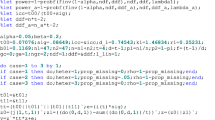Abstract
When analysis of covariance is used for the estimation of an intervention effect, a problem arises when a baseline measurement is available for a particular subject, while all follow-up measurements are missing. This chapter provides and compares different solutions to deal with this problem. These solutions include ignoring these subjects, using an alternative repeated measures (mixed model) analysis and multiple imputation. Besides the comparison between the different solutions and a recommendation regarding these solutions, the chapter also includes a discussing about the use of sensitivity analysis.
Access this chapter
Tax calculation will be finalised at checkout
Purchases are for personal use only
Similar content being viewed by others
References
European Medicines Agency. (2010). Guideline on missing data in confirmatory clinical trials. https://www.ema.europa.eu/documents/scientific-guideline/guideline-missing-data-confirmatory-clinical-trials_en.pdf)
Fiero, M. H., Hsu, C.-H., & Bell, M. L. (2017). A pattern-mixture model approach for handling missing continuous outcome data in longitudinal cluster randomized trials. Statistics in Medicine, 36, 4094–4105.
Gravel, J., Opatrny, L., & Shapiro, S. (2007). The intention-to-treat approach in randomized controlled trials: Are authors saying what they do and doing what they say? Clinical Trials, 4, 350–356.
Hollis, S., & Campbell, F. (1999). What is meant by intention-to-treat analysis? Survey of published randomized controlled trials. BMJ, 319, 670–674.
Little, R. J. A. (1993). Pattern-mixture models for multivariate incomplete data. Journal of the American Statistical Association, 88, 125–134.
Little, R. J. A. (1994). A class of pattern-mixture models for normal incomplete data. Biometrika, 81, 471–483.
Molenberghs, G., & Kenward, M. G. (2007). Missing data in clinical studies. Hoboken: Wiley.
Morris, T. P., White, I. R., & Royston, P. (2014). Tuning multiple imputation by predictive mean matching and local residual draws. BMC Medical Research Methodology, 14, 75–87.
Mukaka, M., White, S. A., Terlouw, D. J., Mwapasa, V., & Kalilani-Phiri, L. (2016). Is using multiple imputation better than a complete case analysis for estimating a prevalence (risk) difference in randomized controlled trials when binary outcome observations are missing. Trials, 17, 341.
Murray, E. J., Claggett, B. L., Granger, B., & Solomon, S. D. (2020). Adherence-adjustment in placebo-controlled randomized trials: An application to the candesartan in heart faillure randomized trial. Contemporary Clinical Trials, 90, 105937.
Tsonaka, R., Verbeke, G., & Lesaffre, E. (2009). A semi-parametric shared parameter model to handle nonmonotone nonignorable missingness. Biometrics, 65, 81–87.
Twisk, J., de Boer, M., de Vente, W., & Heymans, M. (2013). Multiple imputation of missing values was not necessary before performing a longitudinal mixed-model analysis. Journal of Clinical Epidemiology, 66, 1022–1028.
Twisk, J. W. R., Rijnhart, J. M., Hoekstra, T., Schuster, N. A., ter Wee, M. M., & Heymans, M. W. (2020). Intention-to-treat analysis when only a baseline value is available. Contemporary Clinical Trials Communications, 20, 100684.
van Buuren, S. (2007). Multiple imputation of discrete and continuous data by fully conditional specification. Statistical Methods in Medical Research, 16, 219–242.
van Dijk, R. A., Rauwerda, J. A., Steyn, M., Twisk, J. W., & Stehouwer, C. D. (2001). Long-term homocysteine-lowering treatment with folic acid plus pyridoxine is associated with decreased blood pressure but not with improved brachial artery endothelium-dependent vasodilation or carotid artery stiffness: A 2-year, randomized, placebo-controlled trial. Arteriosclerosis, Thrombosis, and Vascular Biology, 21(12), 2072–2079.
Warmerdam, L., van Straten, A., Twisk, J., Riper, H., & Cuijpers, P. (2008). Internet-based treatment for adults with depressive symptoms: Randomized controlled trial. Journal of Medical Internet Research, 10, e44.
White, I. R., Carpenter, J., & Horton, N. J. (2012). Including all individuals is not enough: Lessons for intention-to-treat analysis. Clinical Trials, 9, 396–407.
Wilson, I. B. (2010). Adherence, placebo effects, and mortality. Journal of General Internal Medicine, 25, 1270–1272.
Wright, C. C., & Sim, J. (2003). Intention-to-treat approach to data from randomized controlled trials: A sensitivity analysis. Journal of Clinical Epidemiology, 56, 833–842.
Author information
Authors and Affiliations
Rights and permissions
Copyright information
© 2021 The Author(s), under exclusive license to Springer Nature Switzerland AG
About this chapter
Cite this chapter
Twisk, J.W.R. (2021). What to Do When Only a Baseline Measurement Is Available. In: Analysis of Data from Randomized Controlled Trials. Springer, Cham. https://doi.org/10.1007/978-3-030-81865-4_9
Download citation
DOI: https://doi.org/10.1007/978-3-030-81865-4_9
Published:
Publisher Name: Springer, Cham
Print ISBN: 978-3-030-81864-7
Online ISBN: 978-3-030-81865-4
eBook Packages: Mathematics and StatisticsMathematics and Statistics (R0)




